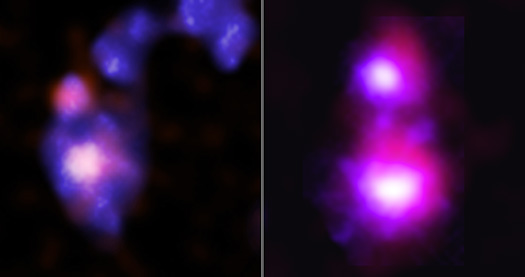For Release: February 22, 2023
NASA/CXC

Credit: X-ray: NASA/CXC/Univ. of Alabama/M. Micic et al.; Optical: International Gemini Observatory/NOIRLab/NSF/AURA
Press Image, Caption, and Videos
Astronomers have discovered the first evidence for giant black holes in dwarf galaxies on a collision course. This result from NASA’s Chandra X-ray Observatory has important ramifications for understanding how the first wave of black holes and galaxies grew in the early universe.
Collisions between the pairs of dwarf galaxies identified in a new study have pulled gas towards the giant black holes they each contain, causing the black holes to grow. Eventually the likely collision of the black holes will cause them to merge into much larger black holes. The pairs of galaxies will also merge into one.
Scientists think the universe was awash with small galaxies, known as “dwarf galaxies,” several hundred million years after the big bang. Most merged with others in the crowded, smaller volume of the early universe, setting in motion the building of larger and larger galaxies now seen around the nearby universe.
Dwarf galaxies by definition contain stars with a total mass less than about 3 billion times that of the Sun, compared to a total mass of about 60 billion Suns estimated for the Milky Way.
The earliest dwarf galaxies are impossible to observe with current technology because they are extraordinarily faint at their large distances. Astronomers have been able to observe two in the process of merging at much closer distances to Earth, but without signs of black holes in both galaxies.
“Astronomers have found many examples of black holes on collision courses in large galaxies that are relatively close by,” said Marko Micic of the University of Alabama at Tuscaloosa, who led the study. “But searches for them in dwarf galaxies are much more challenging and until now had failed.”
The new study overcame these challenges by implementing a systematic survey of deep Chandra X-ray observations and comparing them with infrared data from NASA’s Wide Infrared Survey Explorer (WISE) and optical data from the Canada-France-Hawaii Telescope (CFHT).
Chandra was particularly valuable for this study because material surrounding black holes can be heated up to millions of degrees, producing large amounts of X-rays. The team searched for pairs of bright X-ray sources in colliding dwarf galaxies as evidence of two black holes, and discovered two examples.
“We’ve identified the first two different pairs of black holes in colliding dwarf galaxies,” said co-author Olivia Holmes, also of the University of Alabama at Tuscaloosa. “Using these systems as analogs for ones in the early universe, we can drill down into questions about the first galaxies, their black holes, and star formation the collisions caused.”
One pair is in the galaxy cluster Abell 133 located 760 million light-years from Earth. The other is in the Abell 1758S galaxy cluster, which is about 3.2 billion light-years away. Both pairs show structures that are characteristic signs of galaxy collisions.
The pair in Abell 133 appears to be in the late stages of a merger between the two dwarf galaxies, and shows a long tail caused by tidal effects from the collision. The authors of the new study have nicknamed it “Mirabilis” after an endangered species of hummingbird known for their exceptionally long tails. Only one name was chosen because the merger of two galaxies into one is almost complete.
In Abell 1758S, the researchers nicknamed the merging dwarf galaxies “Elstir” and “Vinteuil,” after fictional artists from Marcel Proust's "In Search of Lost Time." The researchers think these two have been caught in the early stages of a merger, causing a bridge of stars and gas to connect the two colliding galaxies.
The details of merging black holes and dwarf galaxies may provide insight to our Milky Way’s own past. Scientists think nearly all galaxies began as dwarf or other types of small galaxies and grew over billions of years through mergers.
“Most of the dwarf galaxies and black holes in the early universe are likely to have grown much larger by now, thanks to repeated mergers,” said co-author Brenna Wells, also of the University of Alabama at Tuscaloosa. “In some ways, dwarf galaxies are our galactic ancestors, which have evolved over billions of years to produce large galaxies like our own Milky Way.”
“Follow-up observations of these two systems will allow us to study processes that are crucial for understanding galaxies and their black holes as infants,” said co-author Jimmy Irwin, also from the University of Alabama at Tuscaloosa.
A paper describing these results is being published in the latest issue of The Astrophysical Journal and a preprint is available here.
NASA's Marshall Space Flight Center manages the Chandra program. The Smithsonian Astrophysical Observatory's Chandra X-ray Center controls science operations from Cambridge, Massachusetts, and flight operations from Burlington, Massachusetts.
Media Contacts:
Megan Watzke
Chandra X-ray Center, Cambridge, Massachusetts
617-496-7998
mwatzke@cfa.harvard.edu
Dr. Peter Edmonds
Chandra X-ray Center, Cambridge, Massachusetts
617-571-7279
pedmonds@cfa.harvard.edu


